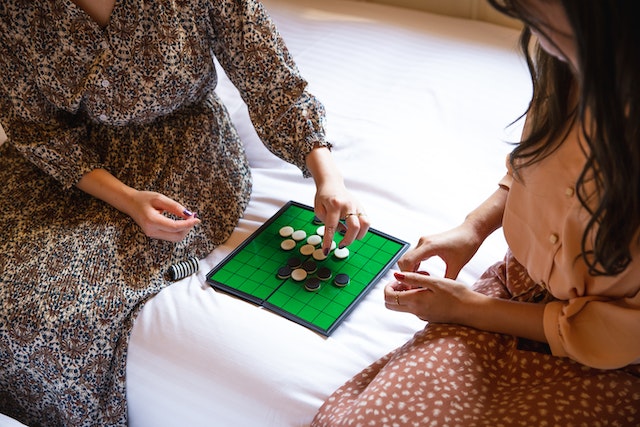The traditional Japanese logic board game for two players is known as Gomoku. It is similar but more complex than the game Tic-Tac-Toe. A traditional Gomoku board has a 15×15 grid of lines. But sometimes, it plays on a Go board having a 19×19 grid of lines. Let us see how to play Gomoku. Also, the meaning and step-by-step guidance of this simple but challenging Japanese game are depicted below—
What is Gomoku?
Gomoku is a simple board game but challenging. It can be enjoyed by any players of all ages. It is also known as a game of “Five in a Row”. Therefore It is traditionally played by two players only.
There are black and white colored round-shaped stones in two bowls. It can be played on a board containing a 19×19 grid. It can also be played on smaller grids. The grid may be 13×13 or 9×9. The main target is to get five stones of the same color. These five stones should be in the same row. Those rows may be horizontally, vertically, or diagonally.
Meaning of Gomoku:
In the Japanese language, Gomoku is referred to as “gomokunarabe”. “Go” means five. “Moku” means pieces and “narabe” means line-up. That means five pieces of stones of the same color to be lined up in a row. The row may be vertically, horizontally, or diagonally.
This game is popular in China also. In Chinese language, it is known as “Wuziqi”.
The Basic Concept of Gomoku:
It’s basically a two-player board game. Both players compete to control more territory than the opponent. The board is usually a square shape. The board contains a grid of 19 horizontal and 19 vertical lines on it. There are two bowls containing black and white pieces of identical stones. There are no other stones with special abilities. The bowl containing black stones is to be kept on one side of the boards. The other bowl containing white stone is to be placed on the other side of the board.
Let us see how to play Gomoku. Both players take turns placing their stones on the board alternatively. The player with the black stones always goes first. Players can place their stones in an empty space. The stone will have to be placed on the intersection of the grid. These should not be placed in the squares.
The board is empty at the time of start. So the player with black stones has 361 options, as 19×19=361. Once the first black stone is placed in a convenient position, we will not move it to any other place. It can move after capturing it.
Now the turn has come to the player with the white stone. As usual, he will place the first white stone in a convenient position. Then the black stone to be placed. In this way, both players will place their stones one after another to make a fence. That will define a border around their territory.
One more point from the other player is sufficient to win the game. Once all of the spaces of the grid are filled, the game is over. The winner will have to place five stones in a row. The row may be horizontally, vertically, or diagonally.
Gomoku is not a game of destruction. We just need to crash to defeat the opponent. In modern terms, Gomoku is the game of competition between two companies for the same market.
How To Play Gomoku – Step-by-step guidance:
1. Divide the black and white stones evenly between two players:
First of all, we have to divide black and white round-shaped stones into two equal halves.
Keep them in two different bowls.
2. Start the game by placing a black stone on the board:
As per the convention, the player using black stone has the option to start the game. He can place one black stone at the intersection of the grid. The stone should not be placed in any square section of the board. You can place the stone on any intersection of the board during your turn. One piece of stone can be placed on the intersection at one time. It cannot be moved for the rest of the game.
Mathematically, the player containing the black stone will win the match if he plays optimally. But in real-life gameplay, the result may be different.
3. Alternate turns between two players:
During the game, the player using black stones will place the stone first. Then white stone will be placed by the other player. This is the way to complete the game. The time limit per player is 10 minutes for each game.
4. Place 5 pieces of stones in a row to win the game:
You must be the first player to create an unbroken line of 5 pieces of stones. The line direction may be horizontally, vertically, or diagonally.
The winning lines must be exactly 5 stones and no more. Rows of more than 5 stones are called overlines and do not count.
How to play Gomoku to win – Some Important Tips:
The following tips to be followed to win the game—-
- Try to take your turn first.
- Utilize the time to complete the game by your opponent.
- Focus on the first 10 moves
- Try to learn the strength and style of your opponent.
- Try to block your opponent from achieving an open 4
- Try to create a fork.
Difference between Gomoku and Renju:
Gomoku is a family-friendly game but Rejnu is a more serious game.
The player with black stone may win the match for most of the time. But for Renju sport, the black player is not allow to make the 3×3, 4×4 fork, or overline.
Renju is a professional variant of Gomoku. It uses more sophisticated rules.
Conclusion:
This simple and challenging game will be more enjoyable with a little practice. There is no age limit to play this game. We can play this game with any family member, or friend or even with a computer. Let’s try to play after taking guidance from the section of this article – “How to play Gomoku”
Frequently Asked Questions(FAQs):
First, see the section of this article “How to play Gomoku” to clear the basic concept of playing this game. When a player plays the game Gomoku, he has to put 5 stones in a row. But if the player puts 6 or more stones in a row, it is called “overline”.
The “Open 4” is a term used for Gomoku. It means a line of stones that has spaces at both ends. In this situation, there is no way to win the game. Don’t allow the opponent to take this opportunity. We have to start blocking when there is a line of three pieces. We have to oppose to move the opponent by blocking one end of open 4.
We can attack the opponent by creating two different lines from different angles. This is an aggressive posture to win the game, Gomoku.










